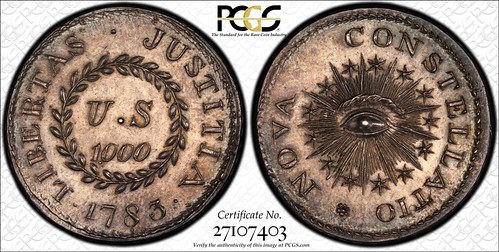
PREV ARTICLE
NEXT ARTICLE
FULL ISSUE
PREV FULL ISSUE
THE NOVA CONSTELLATIO MARK: 1,000 UNITS

Last week we published a PCGS press release about a set of important American colonial coins to be displayed at next month's convention of the American Numismatic Association. Regarding the following passage, The 1783-dated Nova Constellatio patterns in the display will be the unique copper 5 Units, graded PCGS PR66BN; one of three known silver 100 Units (known as a "Mark"), PCGS PR66; the unique Type 1 silver 500 Units ("Quint'), PCGS PR65+; and the unique silver 1000 Units, PCGS PR65+. Bill Eckberg writes: I am pretty sure the "Mark" is the 1,000 unit pattern, not the 100, which was a "Bit" or "Cent."
By George, he's right. I completely missed that, and I guess most of our readers did, too, because no one else has commented on this yet. Here's an excerpt from the University of Notre Dame Coins of Colonial and Early America web site built and maintained by Louis Jordan.
-Editor
On May 1, 1784 Robert Morris sent a letter with specimens of his coinage to Thomas Jefferson. Ten days later on May 11, just before leaving Annapolis to travel to Boston where he would board a ship for a four and a half year trip to England and France, Jefferson recorded in his account book, "left with C. Thomson as specimen of coins 1.8 D." This is usually taken to mean Jefferson deposited 1.8 dollars (or 1,800 units) in Nova Constellatio patters with Charles Thomson, Secretary of the Continental Congress. The denominations of the coins are thought to have been one 1,000 unit mark, one 500 unit quint and three 100 unit cents. At least two of the currently extant coins (the 1,000 and a 500 unit coin) can be traced back to this group. The unique example of the 1,000 unit silver mark coin weighs 268.5 grains according to the Garrett catalog and 269.8 grains according to Breen with a diameter of 33 mm. The coin was passed from John Haseltine to Henry S. Adams, Lorin Parmelee, H.B. Smith, the Chapman Brothers, George Earle, James Ellsworth, John Garrett and then to the current owner John J. Ford, Jr. On the obverse there is a six petal rosette located in the space midway between the start of NOVA and the end of CONSTELLATIO. On the reverse the denomination is designated as 1.000; there is also a stop before and after the date. Excellent photographs are available in the first (November 1979) Garrett Auction catalog, where it is item 622. There are three surviving examples of the 100 unit silver cent. Two examples have the twin olive leaf edge design while the third example has a plain edge. One of the leaf edge examples was acquired by John Ford from the Garrett sale. The Ford example weighs 27.7 grains according to the Garrett catalog and 27.75 according to Breen with a diameter of 18 mm; it is illustrated in the Garrett sale catalog as item 619. According to Breen this coin can be traced from the London pawnbroker T.F. Cloud to L.E. Shorthouse, Lorin Parmelee, Henry Chapman, James W. Ellsworth, Knoedler Galleries, Wayte Raymond and then to John W. Garrett. The other specimen is first recorded in an Edinburgh coin auction from October 21-22, 1884 conducted by T. Chapman of the collection of William Taap and several other cabinets, as is related by Richard Margolis in the Colonial Newsletter. Apparently the item was uncovered in a London pawn shop in the 1980's and most recently was sold at auction by Stack's (May 1, 1991, Richard Picker sale, lot 112). According to Breen the unique plain edge 100 unit cent weighs 26 grains with a diameter of 18 mm. The early provenance of this item is unknown, during the late Ninteenth century it was owned by J.G. Murdoch, whose collection was sold by Sotheby's in 1903. It then passed to Robert Garrett as part of the family's collection. In the 1920's John Works Garrett sold it as a duplicate to Wayte Raymond. After passing through some dealers the coin is now in the collection of Eric P. Newman. Bill adds: I thought the 100 was a "cent" until I looked in my Red Book, which says "bit".
The Breen Encyclopedia called the 100 a "Bit" as well.
It's definitely not a "Mark", which is the 1000 piece.
Time for another correction, this time to the UND site: the coins were FORMERLY the property of John Ford, but are now held by the anonymous buyers who purchased them from his estate. I contacted Lou who's vacationing, but he will have the site updated. I also checked with Donn Pearlman, and there was a revised news release that with corrected information about the "Bit" and "Mark". This was a fun exercise, though. -Editor To read the complete article, see: The Nova Constellatio Patterns of 1783: Introduction (www.coins.nd.edu/ColCoin/ColCoinIntros/NovaPatterns.intro.html)
By the way, LinkedIn (via Google) tells me "There are 7 professionals named Mark Quint, who use LinkedIn..." Hmmm. Maybe they'll be bidders the next time the set comes up for sale.
-Editor
To read the earlier E-Sylum article, see: THE NOVA CONSTELLATIO PATTERN SET DISPLAY AT THE 2013 ANA (www.coinbooks.org/esylum_v16n30a15.html) THE BOOK BAZARREWayne Homren, Editor The Numismatic Bibliomania Society is a non-profit organization promoting numismatic literature. See our web site at coinbooks.org. To submit items for publication in The E-Sylum, write to the Editor at this address: whomren@gmail.com To subscribe go to: https://my.binhost.com/lists/listinfo/esylum All Rights Reserved. NBS Home Page Contact the NBS webmaster 
|